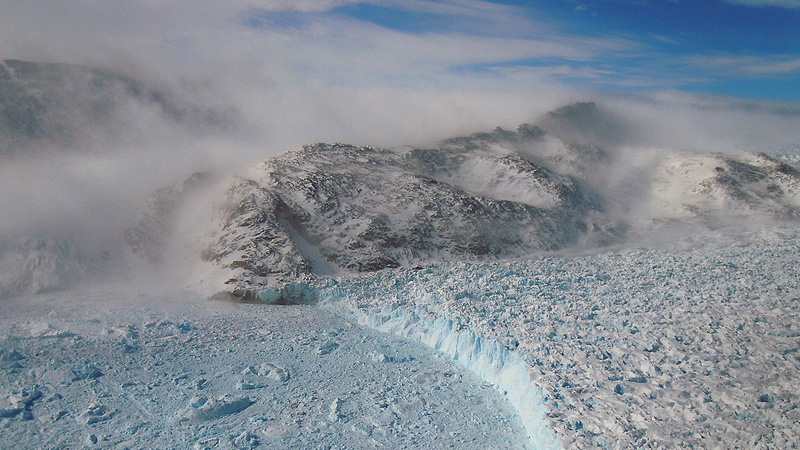Seismic waves that race through Greenland’s bedrock may help answer questions about the pattern of melting and freezing over the Northern Hemisphere’s biggest single sheet of ice.
Scientists need answers because Greenland remains a puzzle: the glaciers may be accelerating their pace towards the sea − but, despite rising temperatures, the interior is not losing ice, according to a second study.
A third study presents a new paradox: there may be little ice melt over most of the icecap, but changing climatic conditions suggest that less snow is falling.
There is enough ice packed on Greenland to raise global sea levels by seven metres if it all melts. Right now, the flow from the island’s glaciers is probably pushing up sea levels by 0.6mm a year.
Harsh conditions
There is repeatedly confirmed evidence that glaciers are melting at an accelerating rate, and several consequences of global climate change that suggest that this process will go on accelerating.
But research in Greenland’s harsh conditions is challenging, and year-round continuous observation so far has been almost impossible, even with airpower and satellite studies.
German Prieto, assistant professor of geophysics in the department of Earth, atmospheric and planetary sciences at the Massachusetts Institute of Technology, and colleagues report in Science Advances journal they could exploit the one source of evidence that would never falter.
The waves that crash on the coastline send tiny seismic shudders through the rock, and seismic wave velocity changes with rock density. So the reasoning is that changes in the mass of ice pressing down on the rocks could be revealed by changes in the speed of the waves through the rock.
“Every time we go back to Greenland, the edge of the ice is further away from the coast”
“With our technique, we can continuously monitor ice sheet volume changes associated with winter and summer,” Dr Prieto says. “That’s something that global models need to be able to take into account when calculating how much ice will contribute to sea level rise.”
Ocean waves generate signals that sensors can pick up continuously, and Dr Prieto says: “They happen 24 hours a day, seven days a week, and they generate a very small signal, which we generally don’t feel. But very precise seismic sensors can feel these waves everywhere in the world. Even in the middle of continents, you can see these ocean effects.”
The scientists recorded seismic data from a small network of sensors on Greenland’s west coast between January 2012 and January 2014, and could detect changes in wave velocity of as little as 1%.
They recorded very large slowdowns in 2012, compared to 2013, and these matched satellite observations of abnormally large melting that year, which suggests that climate science now has another way of looking at changes in the ice.
But Max Berkelhammer, assistant professor in the department of Earth and environmental science at the University of Illinois, and colleagues report in the same journal that, if anything, ice could be accumulating at the centre of the island.
The scientists collected three years of data from Greenland’s Summit Camp, which is 3,200 metres above sea level. They found that snow – which, if it were rain, would be somewhere between 2cm and 10 cm a year – is settling on the island’s heart. Since the high ice at the heart of the island stays far below freezing point, that suggests that 40% of the ice cover rarely experiences melting.
The researchers were interested in the rate at which ice and snow could sublimate and be dispersed by the winds. Overall, they could find no net loss of ice − but that does not mean climate change is not affecting the island.
“This is small potatoes compared to the calving that’s going on along the coasts,” Dr Berkelhammer says. “Every time we go back to Greenland, the edge of the ice is further away from the coast.”
More moisture
One factor at work in maintaining stability is climate change itself, according to a study in Science Advances. As air warms, it can hold more moisture. So, in a warming world, precipitation should be on the increase and snow should be accumulating.
Hans Christian Steen-Larsen, postdoctoral researcher in the Centre for Ice and Climate at the Niels Bohr Institute of the University of Copenhagen, and colleagues measured the water vapour over the ice sheet for three years.
They identified an insulating layer of air over the surface of the ice sheet that formed each winter to screen the high heart of the island from both evaporation and precipitation, and isolate the ice from changes in the upper atmosphere.
Stagnant air keeps the surface cold and dry. Just 100 metres higher, the atmosphere is much more dynamic. Ultimately, such research could pay off in a better understanding of climate change.
“We have simply discovered an important process that helps to explain why there is no relationship between temperature and precipitation on the Greenland ice sheet,” Dr Steen-Larsen says.
This article was produced by Climate News Network
